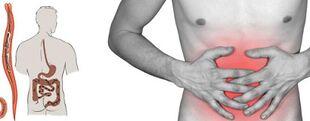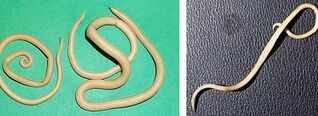
As you know, parasites are the most resistant organisms to the external environment. To date, about 250 species are known as helminths that can infect humans. All pose a threat to health and, in more severe cases, to the lives of those infected. Knowledge of the types and characteristics of helminths in humans greatly simplifies treatment and helps to develop an effective prophylactic plan.
What worms do humans have?
It takes a long time to get acquainted with the types of worms. The fact is that so far scientists have not been able to provide the most detailed information on the classification of parasites. This is due to the fact that a certain area is characterized by the presence of specific helminthic invasions. From this point of view, it is almost impossible to obtain information about all human helminths that exist on earth.
Thus, most of the worms diagnosed in the southern zone are practically not found in the population of the northern geographical areas. About 20 species of worms are known to be most common for temperate and temperate latitudes. These can be conventionally divided into 3 main categories:
- Round parasitic worms (nematodes).
- ribbon ribbons (cestodes).
- Flatworms (trematodes).
1. Round and straight helminths
Each of the above groups includes a large number of parasitic organisms that require a brief description. In children and adults, it is often necessary to treat such representatives of the worms belonging to the class of trematodes:
- Chinese defect;
- cat mixture;
- liver mixture.
Among the nematodes, there are 7 most common and most popular types of parasites that live in the body at any age. Roundworms transmitted by any possible means are:
- pinworms;
- roundworm;
- intestinal acne;
- corn;
- Trichinella;
- trichostrongylides;
- angurt worms.
2. Cestode invasions
Tapeworms (or cestodes) are parasitic worms that pose the greatest threat to the body. Diagnosis of such helminthic infections is less common in children and adults than in roundworm infections, but infection with the following types of worms is fraught with the most serious consequences:
- the bull formed a ribbon;
- dwarf tapeworm;
- pig tapeworm;
- wide ribbon;
- echinococcus;
- the rat formed a ribbon.
Acanthocephalus can be considered one of the rare helminthic invasions. These include the giant chain and the beaded chain. Such worms can rarely enter the body, for example, when they eat an insect infected with parasites or its larvae.
Why are worms dangerous to humans?
In order to adequately assess the degree of danger to a patient's health in a helminth solution, it is first necessary to determine what type of worms they belong to. Treatment and duration depend on the type of worms. The main damage from the presence of parasites in the body is felt in the intestines - most of all helminths are localized in this organ. All the foods that a person needs to assimilate and benefit are selected by worms.
At this time, other worms are not only located in the intestines, but also "steal" from humans all the necessary valuable micronutrients. They actively multiply and affect other vital human organs and systems. In addition to the heart muscle, liver and lungs, worms can cause great damage to the brain and blood vessels. Worms can even infect the eyes.
The main ways of worm infection

If you know how certain types of helminths enter the body, you can protect yourself and your loved ones from the onset of the disease. The only way to take all the necessary measures in time and minimize the risk of infection. The main transmission routes are known:
- Infection occurs through soil and water. When walking on the ground barefoot, the risk of laying eggs inside increases several times. There may be worm larvae from an untested drinking source and, in general, from a common water supply.
- Helminth eggs enter the body along with animal products. The result of helminthic invasions is insufficient or poor processing of meat, fish, seafood and eggs. People who prefer exotic Asian cuisine are at risk of getting worms. It is based on sushi, sashimi raw fish and meat.
- Some types of parasites can enter the intestines with unwashed vegetables and fruits. Refusal of animal products does not solve the problem of the possibility of developing helminthiasis. The worms' eggs, as mentioned earlier, can be in the ground. It is recommended to pour boiling water on any fruit before use.
- Worms pass through humans and animals. It is often not a source of infection for pet owners. However, worms can be found both inside the animal and in its fur. The eggs of parasites from dogs and cats fall to the ground and are further spread by melted water.
Transmission of parasites from patients
Worms can be transmitted from one infected person to another. There are several ways of transmitting helminthic invasions:
- from unwashed hands (for example, when shaking hands, hugging);
- when using common containers;
- when wearing someone else's underwear;
- Application of personal hygiene products by several people.
Pinworm eggs are most often passed from person to person, often falling under the nail plates and staying there for a long time. The prevalence of this type of worm in children is explained by a negligent approach to hygiene rules. The child can simply put his hands in his mouth or bite his nails, so pinworms have no difficulty in penetrating a new human body. At this stage, the task of parents is to recognize the symptoms of helminthiasis in their infants, who immediately begin to treat the disease, and to prevent the development of helminthic invasions.
Symptoms of the acute stage of helminthiasis
Early signs of parasitic infection are not easy to detect in adults or children. The diagnosis of the presence of worms is complicated by the fact that in some species the incubation period can last up to a year and a half.
As a rule, the first symptoms of a worm attack appear at different times. In addition, the course of helminthiasis can be conventionally divided into 2 stages:

- acute phase (lasts more than two months on average after the incubation period);
- chronic (characterized by the development of sexually mature parasites and can last for decades).
The main, clearly expressed symptom in the acute phase of the occupation can be called an allergic reaction. Pathological manifestations in the skin as a result of the production of antibodies against the migration of parasitic larvae should be alerted. The following symptoms are indications of human infection with all types of worms:
- hyperemia of the skin;
- burning sensation and itching;
- small rashes on the surface of the epidermis or mucous membrane;
- slight increase in lymph nodes;
- local edema;
- sternum pain (before choking attacks);
- vomiting and persistent nausea;
- diarrhea or constipation.
In addition, dangerous pathologies such as pneumonia, meningoencephalitis, hepatitis can become a complication of appearance in the body of other living things.
A reliable confirmation of the presence of helminths in the internal organs is an indicator of eosinophils in a clinical blood test. The increasing value of these particles is caused by dysproteinemia - a violation of the normal numerical ratio between protein fractions.
Types of symptoms in chronic form of the disease
Symptoms of chronic helminthiasis in humans are predetermined by the localization of parasite colonization. Simply put, the manifestations of the disease will depend on which organ becomes the main habitat for a particular type of worm.
In particular, the most common parasitism in the intestines of roundworms can persist without the slightest symptoms. If larger species are affected by worms, the symptoms of the disease will be noticeable as the worms reach adulthood. Dyspeptic disorders, pain syndrome and neurotic manifestations in an adult and a child are characteristic features. Ascariasis is often characterized by the development of intestinal obstruction and pancreatitis, and the risk of oncological diseases increases.
Anti-parasitic drugs
Helminthiasis should be treated at the earliest stage. An effective therapy will be if you know exactly which parasite is in the body before starting. Today there are many anthelminthic drugs.
These are different types of drugs that can target a specific type of worm. More potent worm drugs are broad-spectrum drugs and are excellent for the treatment of combined helminthiasis. Both are considered toxic, have many side effects and contraindications. The use of such drugs should be carried out with extreme caution only after medical advice.
Most types of worms in adults need long-term and continuous treatment. Parasitologists often prescribe several antihelminthic drugs at the same time.
The regimen and dosage of a particular drug should be prepared only by a specialist. This will help prevent allergies and serious side effects. For some types of helminthic infections, treatment must be repeated. This is because most adult worms are neutralized during the first therapy, but some larvae and worm eggs remain in the patient's body. If left untreated, the worms will return.
Basic Protection Measures
Drug therapy is undoubtedly an important part of the process of getting rid of parasites and in some cases prevention. However, to fight invasive worms, you need to follow the simplest rules to prevent worms. If you ignore the following rules, the treatment will not work:
- Wash your hands often, especially after going to the toilet and before eating.
- If you can't clean your hands with soap, it's a good idea to use wet antibacterial wipes.
- Any food should be rinsed thoroughly before cooking.
- It is important that meat and fish are exposed to heat for a long time.
- Use only reliable sources of water for drinking.
- It is extremely important to be tested for worms at least once a year.
















































